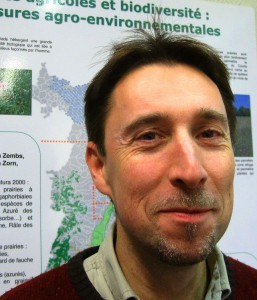 Philippe Osswald - An engineer in charge of protection of environmental conservation at the Alsace Chamber of Agriculture in the Environment and Innovation Department
Philippe Osswald - An engineer in charge of protection of environmental conservation at the Alsace Chamber of Agriculture in the Environment and Innovation Department
He helps farmers reconcile their activities with the various environmental stakes: Natura 2000, protected areas, marshlands, etc.
Tell us about your mission with the LIFE Alister project.
I contribute to agricultural actions in the LIFE Alister Project that aim to design and experiment agricultural techniques of conservation farming, working together with these farmers. These actions take place in close cooperation with the ONCFS, who are trying to assess the impact of these techniques on hamster survival rates, but also with many farmers, including about fifteen of them who are a part of the CUMA de la Plaine.
I also take care of the coordination and implementation of agricultural actions for the national hamster action plan. With my colleagues from the Chamber of Agriculture, I accompany and lead the AFSAL Association (Farmers and Wild Animals in Alsace), which includes 150 farmers who are engaged in environmental and agricultural measures to promote hamster preservation. They get together several times during the year to decide on crop locations that are favourable to hamsters, trying to place them near the burrows listed by the ONCFS. These meetings spark discussions on the European Hamster, between the ONCFS and other State services, such as the DDT and the DREAL. We speak about agricultural cropping programmes, changes in hamster populations, LIFE Alister Project actions, and sometimes compensatory measures that should be rolled out to have the right to build.
What do you find the most motivating in this mission?
I can attest to the fact that farmers are often seen as a problem when their practices don’t take the natural habitat that they are working in into account. In the past few decades, they proved that they can change to comply with injunctions of European agricultural policies as well as societal expectations, and I’m convinced that they are also the solution to many a problem. They have a pragmatic approach to problems and have very useful know-how to roll out concrete actions. It’s really stimulating whilst at the same time extremely complex to collectively manage a region and to aim for innovative agricultural techniques. But all the work that I’ve done with this project contributes to building agricultural systems that will be able to tackle other problems, such as combatting erosion, adapting to climate change or rising prices in energy and agricultural farm inputs. Farmers all over are trying all sorts of things such as these. Going the extra step to better contribute to maintaining biodiversity is undoubtedly possible too, as well as being useful!
What did this partnership bring you?
It’s an interesting approach to try to solve the European Hamster problem, one that is both technical and scientific, rather than being led by emotions or politics. I learned a lot from partners from all walks of life and this partnership has allowed us to observe this little critter that some feel is a nuisance, others see it as a symbol of our local heritage to be protected, or an object of scientific studies where we still have a lot to learn.
And for the future, what would you like to see?
I’d like to continue to be able to count on our farmers and one day, to see all our efforts rewarded!

